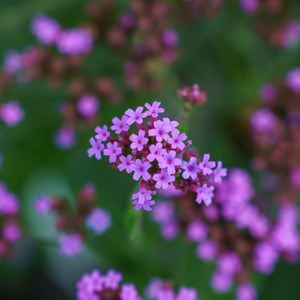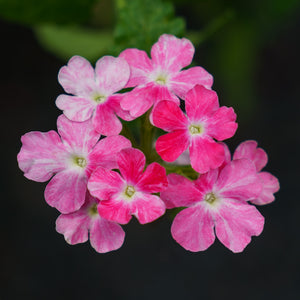The Verbena Guide
Verbena is a vibrant, long-blooming genus of flowering plants known for its resilience, pollinator attraction, and ability to thrive in hot, sunny environments. With both annual and perennial forms, verbena brings nonstop color to garden beds, containers, borders, and wildflower-style meadows. Their clusters of small, five-petaled flowers bloom in an array of colors and support bees, butterflies, and hummingbirds throughout the growing season.
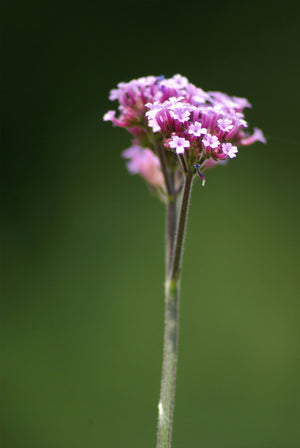
About
Verbena belongs to the Verbenaceae family and includes more than 250 species, many of which are native to the Americas. Some of the most popular ornamental types include Verbena bonariensis, Verbena rigida, Verbena hastata, and various hybrid cultivars developed for landscape or container use.
- Verbena bonariensis 'Meteor Shower', 'Lollipop', and 'Buenos Aires' are tall, airy types with lavender-purple blooms, perfect for naturalistic or pollinator gardens.
- Verbena rigida 'Santos Purple' and 'Vervain' are lower-growing with vibrant purple flowers and a more spreading habit.
- Verbena hastata 'Blue Spires' adds upright structure and spiky blooms to rain gardens and native borders.
- Hybrid selections like Verbena 'Lanai Lime Green' or members of the Superbena Series are ideal for hanging baskets and colorful annual beds.
The wide variety of forms—from groundcovers to tall architectural plants—makes verbena a versatile choice for nearly any garden design.
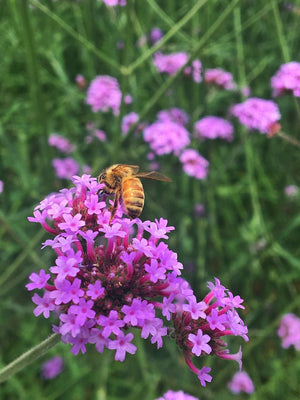
PLANTING
Verbena thrives in sunny, well-drained locations and can be used in a wide variety of landscape settings:
- USDA Hardiness Zones: Perennial types typically hardy in Zones 6–10, depending on species. Treated as annuals in colder zones.
- Soil: Prefers light, well-drained soil. Avoid heavy clay or wet conditions.
- Sunlight: Requires full sun (6+ hours daily) for best flowering performance.
- Spacing: Space plants 12–18 inches apart depending on the variety.
- Planting Time: Plant in spring after the last frost or in early fall in warmer climates.
To plant, dig a hole at least twice as wide as the root ball, place the plant level with the soil surface, and backfill. Water thoroughly after planting and apply mulch to retain moisture and control weeds.
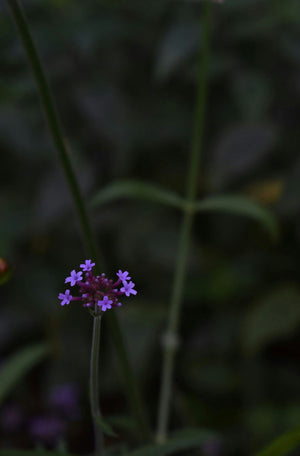
CARE
Verbena is known for being low maintenance but benefits from consistent care to extend its blooming season:
- Watering: Water regularly until established. Once mature, verbena is drought tolerant but prefers consistent moisture in extreme heat.
- Fertilizing: Feed with a balanced slow-release fertilizer in early spring or every few weeks with a diluted liquid fertilizer during the growing season.
- Deadheading: Regular deadheading encourages more blooms, especially for hybrid bedding types like Superbena or Lanai.
- Pruning: Mid-season shearing can rejuvenate leggy or tired plants. Perennial species can be cut back in fall or early spring.
- Disease & Pests: Verbena is generally disease-resistant but may experience powdery mildew in humid areas. Provide good air circulation and avoid overhead watering.
Most varieties are fast-growing and bloom from late spring until frost with proper care.
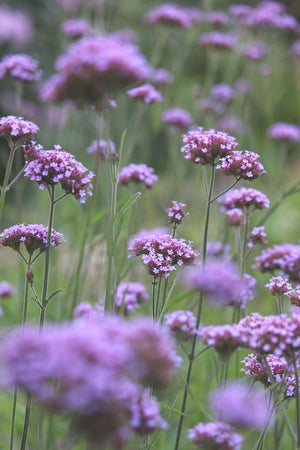
HOW TO USE
Verbena offers a spectrum of possibilities in both formal and wild garden styles, making it a favorite among landscapers and home gardeners alike:
- Pollinator Gardens: Verbena bonariensis and Verbena hastata are magnets for bees, butterflies, and hummingbirds.
- Containers & Hanging Baskets: Compact hybrids like Verbena 'Lanai White' or 'Empress Flair Red' cascade beautifully in mixed containers.
- Borders & Edging: Low-growing species like Verbena rigida 'Santos Purple' are perfect for softening the edge of beds.
- Mass Plantings: Use bold varieties like 'Meteor Shower' or 'Lollipop' to create sweeping drifts in full-sun landscapes.
- Mixed Beds: Pair verbena with other heat-loving companions like salvia, lantana, echinacea, or gaura for layered, dynamic arrangements.
With options for trailing, upright, or compact growth habits, verbena works across a wide range of garden styles.

COMMON QUESTIONS
- What is verbena? Verbena is a genus of flowering plants known for their colorful blooms, pollinator value, and versatility in the garden.
- Is verbena a perennial? Some types, like Verbena rigida and Verbena bonariensis, are perennial in warm climates. Others are grown as annuals.
- Do deer eat verbena? Verbena is generally deer resistant due to its aromatic foliage.
- Do rabbits eat verbena? Verbena is rarely bothered by rabbits.
- Is verbena toxic to dogs? According to the ASPCA, many verbena species are non-toxic, but some hybrid varieties may cause mild irritation if ingested. Use caution.
- Is verbena toxic to cats? Similar to dogs, verbena is considered mildly irritating if ingested by cats.
- Do you deadhead verbena? Yes, deadheading extends blooming and maintains a tidy appearance, especially in trailing and mounding varieties.
- How to grow verbena? Provide full sun, well-drained soil, regular watering, and occasional feeding for best results.
- How to plant verbena? Plant in spring or early summer in sunny, well-drained spots. Space appropriately and water deeply.
- Do hummingbirds like verbena? Yes, especially taller varieties like Verbena bonariensis attract hummingbirds with their nectar-rich flowers.
Conclusion
Verbena is a powerhouse performer in the summer garden, offering months of vivid color with minimal effort. Whether you choose the upright elegance of Verbena bonariensis 'Meteor Shower', the spreading carpet of Verbena rigida 'Santos Purple', or a container-friendly Lanai series cultivar, this plant delivers beauty and pollinator support in equal measure. With thoughtful care and the right placement, verbena is sure to become a mainstay in your sunny garden spaces.
The Verbena Collection
Sold Out
Sold Out
Sold Out
Sold Out

